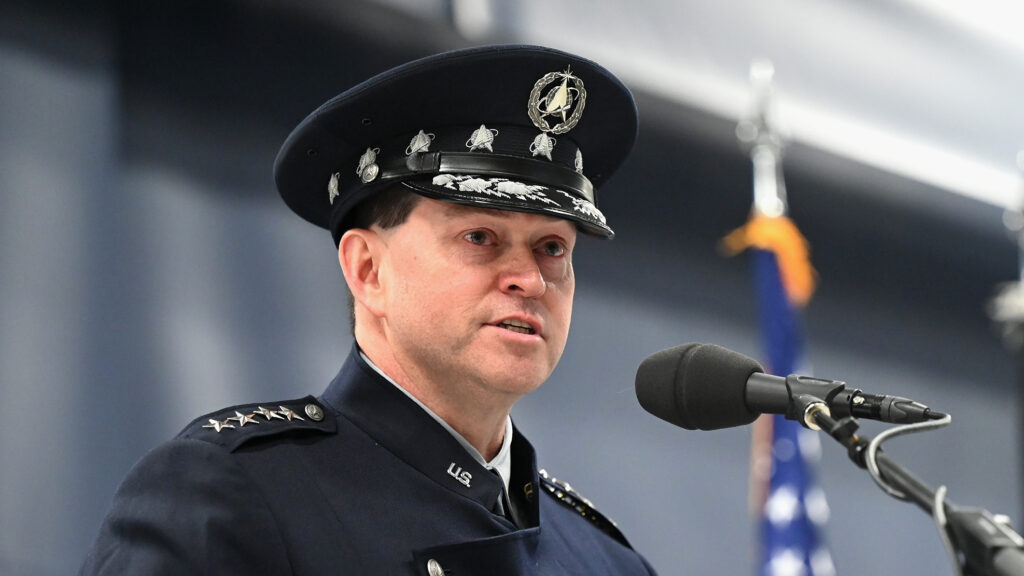
ORLANDO — As it approaches its fourth birthday later this month, the Space Force recently put into place a number of organizational changes that senior leaders see as bringing it closer to the optimal structure to ensure readiness — announcing today the latest move to redesign its field command supporting US Space Command.
That change bifurcates Space Operations Command (SpOC) to separate its organize, train and equip mission from its operational support mission as the Space Force component to SPACECOM. The new operational command, called Space Forces-Space, was activated Dec. 6, the service said in its announcement. It will be led by Lt. Gen. Doug Schiess, who previously was dual hatted as vice commander of SpOC and the leader of SPACECOM’s Combined Force Space Component Command.
Chief of Space Operations Gen. Chance Saltzman told the Space Force Association’s Spacepower conference here today that the reorganization “will allow SpoC to focus on readiness and other service responsibilities, while Space Forces-Space focuses on operations and the needs of US Space Command. I’m eager to see Space Forces-Space provide US Space Command with focused C2 [command and control] and continuous readiness.”
In a media roundtable after Saltzman’s keynote, Schiess echoed that ensuring SpOC’s ability to keep up Guardian readiness was the main motivation behind the change. At the same time, he explained that SPACECOM’s side has reorganized too — streamlining two subordinate units.
“We will, on the US Space Command side, deactivate the Combined Force Space Component Command that I commanded, and the Joint Task Force-Space Defense,” Schiess said. Those two units now will be “wrapped up into US Space Forces-Space.
The Combined Force Space Component Command, located at Vandenberg SFB in California, took care of all the day-to-day space support functions for military operators, such as managing military access to communications satellites and operating GPS satellites. Joint Task Force-Space Defense, headquartered at Schriever SFB in Colorado, was responsible for protecting and defending US space assets, including coordinating with the Intelligence Community through the National Space Defense Center.
The SPACECOM rearrangement gives Schiess “authority over all space forces presented by the services to the combatant command,” the Space Force release explains, under the title of Combined Joint Force Space Component Commander.
Shortly after the activation of Space Forces-Space, the service on Dec. 8 formally stood up another new component: Space Forces Europe and Africa, headquartered at Ramstein Air Base in Germany, to serve US European Command (EUCOM) and US Africa Command (AFRICOM).
“So, SPACEFOR-EURAF supports both the combatant command for EUCOM as well as AFRICOM — two fully separate staffs, two completely different geographical areas, about 50 countries a piece,” explained Col. Max Lantz, the new component’s commander. “And right now, almost every nation is interested in space and is at some level on development on that space process, if you will, from very much more robust, mature countries in Europe to African nations that are really trying to just start to understand how space can help them with their stability issues, climate change issues and really from an Earth monitoring [perspective].”
“I think what you’re seeing across the board with Gen. Saltzman and the leadership at headquarters Space Force, they’re making structural changes to how we are organized within the Department of Defense. And it’s important changes that allow the focus of space to shift really from over the past 40 to 50 [years] supporting the National Command Authorities and the strategic impacts from space to really diving in and focusing on the theaters and taking it down to an operational level of integration to support our field of forces,” he added.
“And so for us, it really feels like we’re going from a pickup game to we’re now the NBA Expansion League and we’re a team that gets to suit up, and go to the games,” Lantz said.
More Shifts To Come
Saltzman made clear in his remarks that while the Space Force is honing on a long-term organizational structure, there is likely to be more restructuring in the not so distant future. In particular, he said the service is looking at expanding its pilot effort launched in September to create Integrated Mission Deltas to other mission sets.
Those Deltas (the Space Force equivalent of an Air Force wing) combine operations and sustainment activities — the latter, traditionally the purview of the service’s key acquisition command, Space Systems Command (SSC) — for specific mission areas under a single leader. At the moment there are two such protoype Deltas: one for electromagnetic warfare, and the other for precision navigation and timing.
“We are already seeing positive results within the organizations and we’re learning lessons that will help us expand the concept to other issues,” Saltzman said — although he didn’t name the next mission areas he had in mind.
In addition, he said that SSC’s parallel experiment to create new “Systems Deltas” to match the two prototype Integrated Mission Deltas also are seeing some success already. The System Deltas are designed “to facilitate authorities across acquisitions for design, test and fielding to the [Integrated Mission Deltas], ensuring integration between operations, acquisitions, training and test,” he explained.
For example, Saltzman said that in November the “integrated ops, engineering and sustainment pros” from “these new constructs” were able to “rapidly resolve” an “anomalous event” encountered by a GPS satellite.
“Going forward, SpOC and SSC are developing the criteria and processes needed to determine which mission system should transition to an [Integrated Mission Delta] and which System Deltas should be stood up. And we’ll keep you posted as that process unfolds,” he said.

